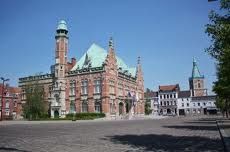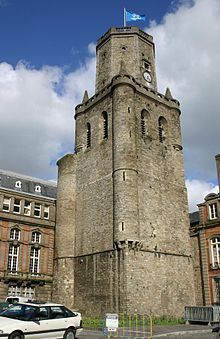(10 am. – promoted by ek hornbeck)
The Tour de France 2012, the world’s premier cycling event kicked off last Saturday with the Prologue in Liège, Belgium and will conclude on July 22 with the traditional ride into Paris and laps up and down the Champs-Élysées. Over the next 22 days the race will take its course briefly along the Northwestern coast of France through Boulogne-sur-Mer, Abbeville and into Rouen then into the mountains of the Jura, Swiss Alps and the Pyrenees.
We will be Live Blogging Le Tour 2012 every morning at The Stars Hollow Gazette starting at 7:30 AM EDT. Come join us for a morning chat, cheer the riders and watch some of the most beautiful and historic countryside in Europe.
 Stage 3 on Tuesday started in Orchies, a commune in northern France. It is the world capital of chicory and especially known for its Musée de la chicorée, the museum of chicory.
Stage 3 on Tuesday started in Orchies, a commune in northern France. It is the world capital of chicory and especially known for its Musée de la chicorée, the museum of chicory.
• Stage town on one previous occasion
• 8,500 inhabitants
• Head of the canton of Nord
The riders will appear for the first time in France in Orchies, which submitted a joint candidacy with Tournai as a Euroregion, a unique happening on the Tour. But Orchies is also one of the rare towns that is a stage that does not have a winner! In 1982, only three teams had set off when the team time-trial was interrupted in Denain by strike action, as a protest against the closure of the Usinor Group. On the other hand, last year, the town may have witnessed the birth of a future great champion, with the victory of Germany’s Marcel Kittel in the 1st stage of the Four Days of Dunkirk.
Many of the streets are cobblestone but Le Tour will be avoiding them. The riders will travel 197 km over a moderately hilly route with an up hill finish in Boulogne-sur-Mer:
Although the two last stages of the Tour which ended in Boulogne-sur-Mer were sprint finishes, with the victories of the Dutch Jean-Paul Van Poppel in 1994, and of the German Erik Zabel in 2001, the profile of the third stage is ideal for initiatives like those which allowed Pierrick Fédrigo and Sylvain Chavanel to obtain the French Champion’s jersey. In 2005, the air of the town greatly inspired Fédrigo, who also won the Four Days of Dunkirk’s pink leader jersey a few weeks earlier.
Originally named Gesoriacum and probably also to be identified with Portus Itius, by the 4th century Boulogne was known to the Romans as Bononia and served as the major port connecting the rest of the empire to Britain. The emperor Claudius used this town as his base for the Roman invasion of Britain, in AD 43, and until 296 it was the base of the Classis Britannica.[citation needed] Zosimus called the city “germanorum”, Germanic speaking, at the end of the 4th century. The city was an important town of the Morini.
In the Middle Ages it was the centre of a namesake county. The area was fought over by the French and the English and Boulogne was occupied by the English from 1544 to 1550. In 1550, The Peace of Boulogne ended the war of England with Scotland and France. France bought back Boulogne for 400,000 crowns.
 In the 19th century the Cathedral of Notre-Dame was reconstructed by the priest Benoit Haffreingue after he received a call from God to reconstruct the town’s ruined basilica. During the Napoleonic Wars, Napoleon amassed La Grande Armée in Boulogne to invade the United Kingdom in 1805. However, his plans were halted by other European matters and the supremacy of the Royal Navy (including thousands of Congreve rockets)
In the 19th century the Cathedral of Notre-Dame was reconstructed by the priest Benoit Haffreingue after he received a call from God to reconstruct the town’s ruined basilica. During the Napoleonic Wars, Napoleon amassed La Grande Armée in Boulogne to invade the United Kingdom in 1805. However, his plans were halted by other European matters and the supremacy of the Royal Navy (including thousands of Congreve rockets)
On 22 May 1940 during the Battle of France, two British Guards battalions and some pioneers attempted to defend Bolougne against an attack by the German 2nd Panzer Division. Despite fierce fighting, the British were overwhelmed and the survivors were evacuated by Royal Navy destroyers while under direct German gunfire.[4] On June 15, 1944, 297 planes (155 Avro Lancasters, 130 Handley Page Halifaxes, and 12 De Havilland Mosquitos) of the Royal Air Force bombed Boulogne harbour to suppress German naval activity following D-Day. Some of the Lancasters carried Tallboy bombs, and as a result, the harbour and the surrounding area were completely destroyed. In August, 1944 the town was declared a “fortress” by Adolf Hitler, but it succumbed to assault and liberation by the 3rd Canadian Division in September. In one incident, a French civilian guided the Canadians to a “secret passage” leading into the walled old town and by-passing the German defenders.
To replace the destroyed urban infrastructure, affordable housing and public facility projects in functional, brutalist building styles were carried out in the 1950s and 60s. The harbour therefore sometimes proves to be a disappointment to tourists looking for a typical northern French harbour scene.
Main sights
* Belfry (11th century), part of the UNESCO Heritage Sites List.
* Medieval castle, whose foundations date to Roman times. It houses an Egyptian art collection
* Gothic church of St. Nicholas, housing several 15th century statues
* Cathedral basilica of Notre-Dame, with a dome standing at over 100 m. The crypt is one of the largest in France, and has Roman, Romanesque and Gothic elements.
* Opened in 1991, Nausicaä – The French National Sea Centre is a science centre entirely dedicated to the relationship between mankind and the sea. It houses Aquaria, exhibitions on the marine fauna, and the exploitation and management of marine resources (fisheries, aquaculture, coastal planning, maritime transport, exploitation of energies and mineral, tourism).
* The Boulogne Eastern Cemetery, created during the Great War
There is a very unique exhibit in front of the Boulogne-sur-mer’s city hall, “The Car Versus Nature”
The result is more garden than graveyard for such auto parts as rearview mirrors, tires, steering wheels and entire bench seats planted among the shrubbery. The group says it’s intended to show that “against the creations of Man, Nature always wins in the end.” Nature is definitely making herself known in the plants growing through the tops of such vehicles as a Citroën 2CV. Walkways are lined with tire treads, leather car seats invite passers-by to stop and have a seat, and gearboxes sit at the main entrances to the display area. In all, six cars, two bicycles, one motorbike and a tractor are “planted” in the installation, along with an uncounted number of vehicle components and accessories.”

Click on image to enlarge for the article, a slide show and a video.

1 comments
Author